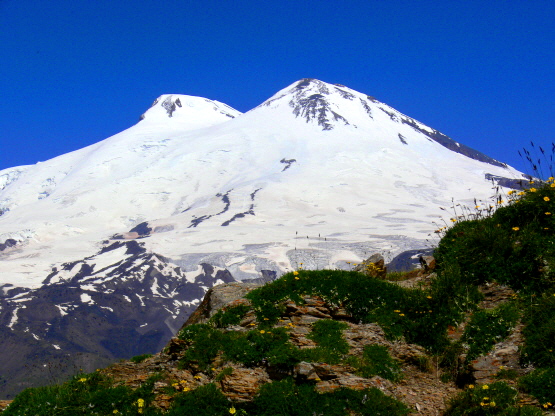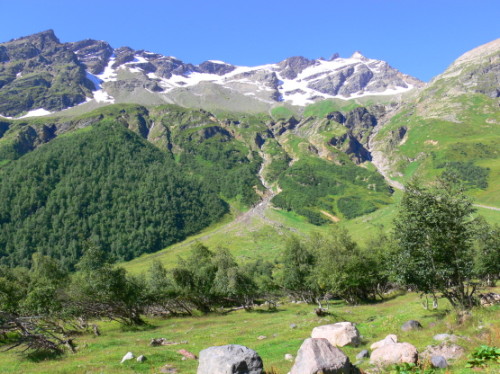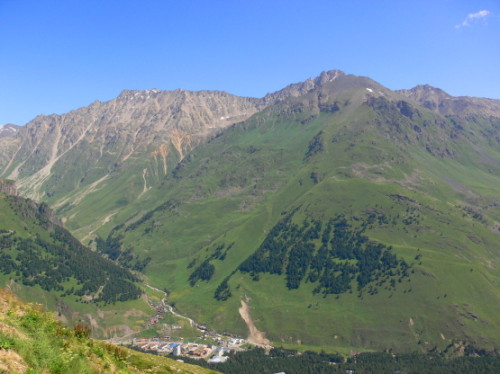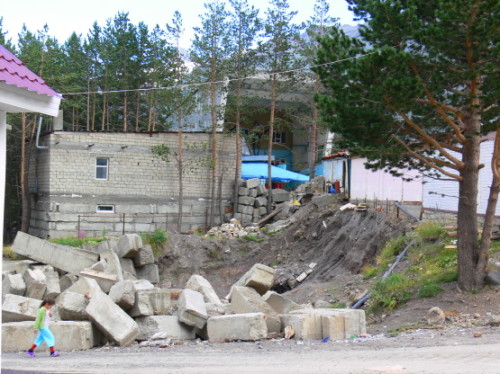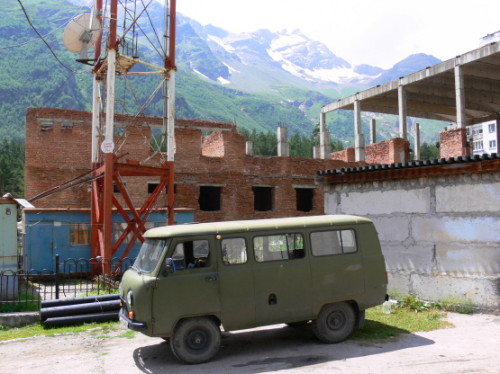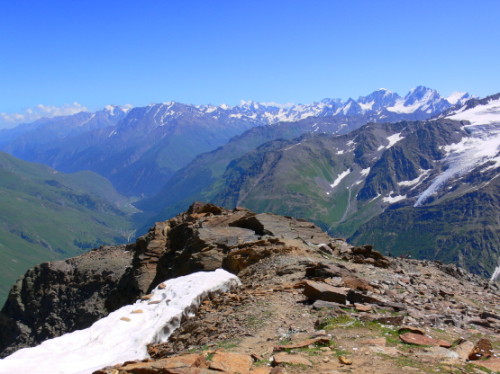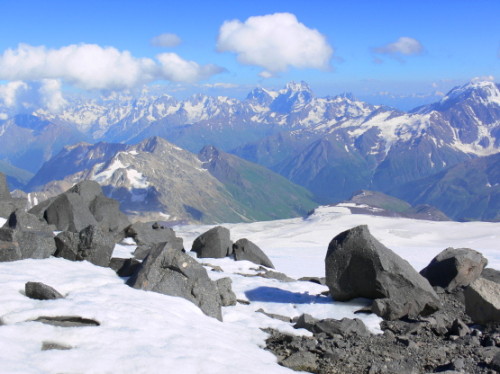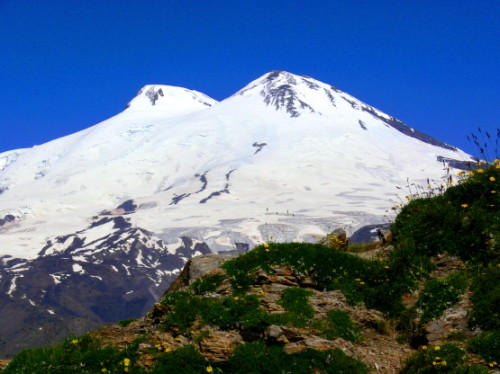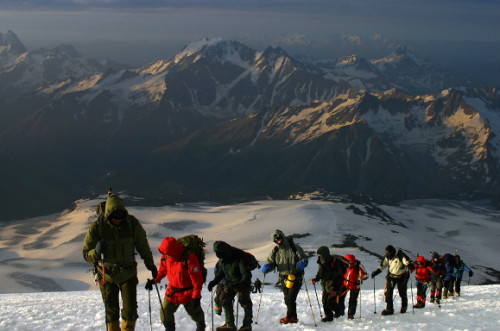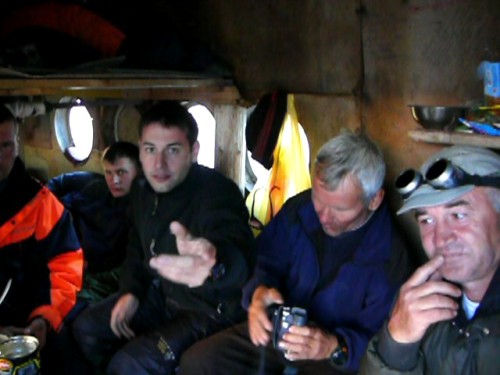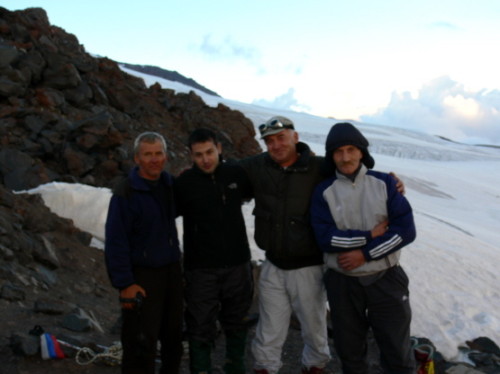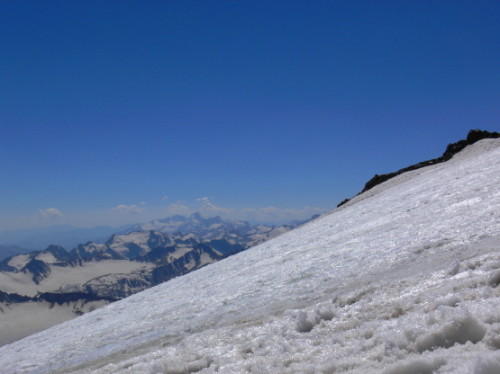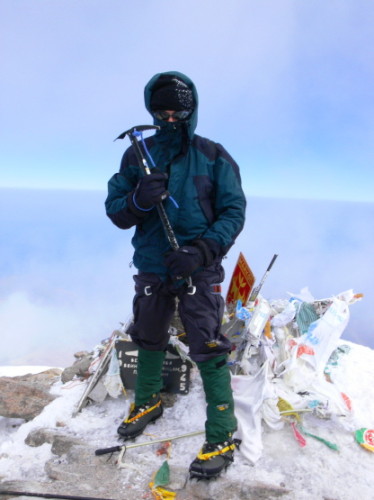Mt. Elbrus
Mt. Elbrus is Europe’s highest mountain, reaching an altitude of 18,510 feet. Climbing Elbrus is similar to Mt. Kilimanjaro but this mountain comes with a few more risks. Kilimanjaro requires nothing more than hiking boots and normal camping equipment. Climbing Mt. Elbrus requires you to step it up a notch with basic mountain gear including climbing boots, crampons and an ice ax.
The year that I attempted this mountain more people had died on Elbrus than on Everest. Of course Elbrus is nowhere near as dangerous as Everest, but often there are climbers who attempt the mountain without the proper gear or experience. Many assume that if the mountain isn’t some giant Himalayan peak then not only is it an easy climb, but there also seems to be an assumption that the challenge doesn’t pose any real risk.
Every outdoor challenge should be taken seriously, especially a glaciated peak that exceeds 5,000 meters. Somewhere halfway up this mountain, I learned what crampons and an ice ax are. My own lack of experience gave me some serious exposure to the dangers of mountaineering. To this day, Elbrus, the second easiest of the Seven Summits, probably remains the closest I’ve ever come to killing myself.
Before I talk about my actual climb I’d like to make a comment about the slight controversy that a few people bring up concerning whether Elbrus is even one of the Seven Summits. Although the vast majority agree that Elbrus is Europe’s highest peak, there is a small group of climbers that consider Mt. Blanc to be the true summit of Europe. Their argument is that Elbrus isn’t even within the continent.
I personally believe Mt. Elbrus is within Europe’s borders for the following reasons. First, let’s agree on the eastern border of Europe, which is known to be Russia’s border with Kazakhstan and the Ural mountains in Siberia. I’ve never heard of anyone disagreeing with this, but even if someone questioned it, all you have to do is consider one of the fiercest battles of World War II, when the Germans fought the Russians in the city of Volgograd (then Stalingrad). This city is far west of the Ural mountains and west of Kazakhstan. Aside from these two facts, I’m pretty confident that any reasonable person would agree that this famous battle did not take place on the Asian front.
With Volgograd on roughly the same latitude as Elbrus, we can now agree that the mountain is within Europe with regard to its eastern border. All we need to do now is go directly south from Volgograd and determine where Europe ends. Of course, randomly drawing a southern borderline makes absolutely no sense, but if you travel only 300 miles south of Volgograd you’ll find a natural wall known as the Caucasus range. The Caucasus mountains span from the Black Sea to the Caspian Sea and includes several peaks reaching over 5,000 meters.
The fact that Elbrus is located on the northern part of the Caucasus wall, should prove that it is within Europe’s southern border, and should close the argument in my opinion. If you still need another reason, then you can still stick with political boundaries. I think political boundaries are a very weak way to determine geographical locations, but nevertheless the mountain is still in the Russian side of the Caucasus mountains.Of course you’re a long way from all of the luxuries of Western Europe, but with nothing else geographically, politically or culturally separating this natural border between Volgograd, I see no logical reason why the border of southern Europe should be defined as north of the Caucasus range. With that said, I went out to try my second of the Seven Summits after a seven year hiatus after Kilimanjaro. These two photos above were some of my first impressions of the Caucasus Mountains, with a tiny village barely visible in the upper right photo where I spent the night.
It was during some of the acclimatization hikes that I got my first great view of Mt. Elbrus, seen on the upper left. From this vantage point, the peak on the left looks lower but it’s actually the true summit of Elbrus. On the right is a photo of my group while we were on another acclimatization hike on the actual mountain. Once I was on the actual mountain, things began to get interesting for me and not in a good way. As I mentioned before, I made some serious mistakes which I actually made the day before we were supposed to summit. Our group was descending from 15,000 feet to our camp after an acclimatization hike. Everyone broke up from the group and we all went at our own pace. Actually, let me cut in and mention that when I arrived in Moscow I got sick since my luggage was lost and I was walking around in the rain wearing a T-shirt. Going from 100F in Washington, DC to 60F and being wet and stressed because of my lost gear didn’t do my immune system any good. By the time I got to Elbrus my nose was a waterfall and I couldn’t sleep for more than a few hours at a time.
While I was hiking down to camp solo, I felt great physically despite being sick. In fact, it seemed like I felt sicker when I wasn’t doing anything rather than when I was moving. My problems began after what seemed like a significant amount of time had passed without anyone or anything in view other than a Russian camp. There are no actual trails on Elbrus since it’s all snow, but fresh footprints from climbers make it obvious where people were traveling. I decided to continue on the path, but as time went on I began to question myself and get worried. Had I somehow come across two tracks in the path and mistakenly taken the wrong one. Was I going farther and farther from my camp? There was also something else that made me question my judgment. From the barrel huts, the false summit appears almost in front of the true summit, but where I was standing at that moment they appeared to almost be side-by-side, similar to my photo above. Worried that I might be hours from my camp and with the sun getting lower and lower in the sky, I made the foolish decision to cut across a large hill that appeared to be in the direction I should be going and to see if I could see people on the other side.
About half a mile above me was the Russian camp. I had figured that since I was in sight of people I couldn’t get lost and would give it a shot. My concerns at this point were things like not returning on time and worrying my group. Also a concern was doubling my trek and being physically exhausted on the start of summit day, not to mention getting more sick. My plan was to peek over the hill and, if I didn’t see anyone, go back and continue the way I had been going. I hiked for about 20 minutes in this direction only to find a white glacier on the other side of the hill. Since these trails are just footprints, it would be impossible to see where people had trekked earlier in the day from any distance. Not seeing any signs of a camp, I realized I had to backtrack.
It was around this time that some people from the Russian camp saw me and came up the hill and began yelling. I had no idea why they were yelling or what they were saying because they were so far away. Finally, when they realized I didn’t speak Russian, they said something I did understand, “go back, go back!” I thought they meant to not continue in the direction I had come from so I headed towards their camp. This made them more frantic, and it wasn’t until one of my legs suddenly fell straight into the snow all the way up to my hip that I understood. I was able to catch myself with my arms and my left leg, which was lying horizontally across the snow while I held myself. I was standing right in the middle of a crevasse field! Before this trip, I never considered the risks of crevasses and, to be honest, I didn’t even know what they were. Crevasses are holes in the ground that can be 10 to 100 feet deep or more and are usually completely covered with snow. This makes them look no different than the rest of the terrain and I had just demonstrated one of the most efficient methods of finding them.
Had I fallen all the way inside I could have been knocked unconscious and, without someone to rescue me in a reasonable time, I’d likely not last long against the cold. If I had fallen in without the Russian camp spotting me, then the chances of being heard or climbing out on my own would have been slim to none. I was able to pull my leg out and then look back into the hole where I could not see the bottom. I took out my ski pole and poked around in the ground. Just about everywhere around me, my ski pole went effortlessly straight through the snow all the way up to my wrist. I spent about 20 minutes poking my way out and zigzagged to safety. At one point I had to jump over a very long but skinny crack in the ground that was probably 50 feet in length. The whole time I was doing this I had an audience of about a dozen people up on the rocks watching to see if I would make it out or not.
Once in the Russian camp, everyone was extremely nice to me and gave me lots of food and made me do shots of vodka, explaining that the area I was in was extremely dangerous. I was taken inside their camp and was asked to stay the night. I didn’t want to be rude so I took the vodka shots they offered and before I knew it they had given five toasts so I was pretty buzzed. I didn’t mind spending the night in their camp, but someone from my group came inside a few hours later since everyone else was still looking for me. The Russians here told me that my group was aware of my location after I asked them repeatedly, but apparently they didn’t understand my questions. Back at my own camp, my guides said we had to celebrate a happy ending, which meant several more shots of vodka. Below are two photos of me inside the soviet airplane at 14,000 feet right before I took my first vodka shots, and outside before my departure back to my camp.
This incident may not sound like a big deal in itself, but four people died on Elbrus just days before my climb, and in the three months earlier, an entire group of nine people climbing together were all killed when they fell down a steep slope on the mountain. It just seemed like death was everywhere on Elbrus, and I was disappointed that I had given Elbrus such an easy opportunity to add me to its toll. Lesson learned; unless you’re a world-class mountaineer, never climb solo, and if you get lost, never trek through unexplored terrain!
